Souris rouge à la mantille (Dupin 751) by Joan Miró

Joan Miró
Souris rouge à la mantille (Dupin 751)
colour aquatint
signed and numbered 7/50 in the lower margin; printed by Morsang and published by Maeght, Paris
44.5 x 29 in ( 113 x 73.7 cm ) ( plate size )
Auction Estimate: $15,000.00 - $20,000.00
Price Realized $10,200.00
Sale date: May 30th 2024
Sinai Health Foundation, Toronto
Roland Penrose, "Miró", London, 1985, pages 116–117
Jacques Dupin, "Miró Engraver: III. 1973-1975", Paris, 1992, catalogue no. 751
Share this item with your friends
Joan Miró
(1893 - 1983)
Born in Barcelona, Spain, in 1893, Joan Miro showed a talent for drawing early in life and began studying at the age of seven, which eventually lead him to study at the Cercle Artistic de Sant Lluc. His first solo exhibition was at the Dalmau Gallery, where his work was met with harsh criticism and defacement. Influenced by artists abroad engaging in Surrealism, Dadaism, and Cubism, Miro was drawn to Montparnasse in Paris, where many ex-pat artists, musicians, and writers were gathering. While he continued to spend his summers in Catalonia, in 1920 Paris became his home for life. In 1924, Miro joined the Surrealist group. The already symbolic and poetic nature of Miro’s work, as well as the dualities and contradictions inherent to it, fit well within the context of dream-like automatism espoused by the group.

